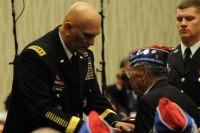WASHINGTON, Nov. 2, 2011 — In a ceremony here yesterday more than 66 years after hostilities ended in World War II, 40 Americans received the Bronze Stars they deserved for combat service in that conflict.
The Japanese-American soldiers fought as part of the 442nd Regimental Combat Team, the 100th Infantry Battalion and the Military Intelligence Service. Army officials decided that all soldiers who wore the Combat Infantry Badge from World War II were owed a Bronze Star; some, however, never received theirs.
Getting such an award, in many cases, depended on “how good your clerk was, … and some of the clerks were not that great,” said retired Army Lt. Gen. Joseph F. Peterson. It’s really a matter of poor paperwork that the soldiers had to wait so long to get their Bronze Stars, he added.
The general organized a three-day recognition of Japanese-American soldiers in Washington, D.C. The highlight has some 800 of those veterans being honored with the Congressional Gold Medal during a ceremony at the U.S. Capitol today. But for the soldiers who gathered yesterday at a posh hotel, the day was about finally getting the Bronze Star they had earned.
At the event, 31 of those soldiers were present to have the medal pinned on their chest by Army Chief of Staff Gen. Raymond T. Odierno. Another nine Bronze Stars were provided to the family members of soldiers who could not attend or who have died.
“It’s amazing to get a star like this,” said Don K. Masuda, one of the recipients of the award. The former soldier attended the event with his wife, his daughter, and two of his grandsons. He said he’s led “a pretty good life” since leaving the Army, which has included being a co-owner of a shipping business in his native Hawaii, and also working six years for the postal service.
He served as an infantryman in World War II, in both Italy and France, as part of the 442nd RCT. He earned two Purple Hearts during his service. He said he’s been waiting “a pretty long time” to have a Bronze Star.
Fellow 442nd RCT soldier George Joe Sakato was also at the award ceremony — both as a recipient of the Bronze Star and as a speaker. Sakato is one of 21 Japanese-American Medal of Honor recipients to come out of the 442nd RCT and 100th Infantry Battalion.
On behalf of the 33,000 Japanese-Americans soldiers who served in World War II, Sakato thanked Congress for the Congressional Gold Medal they are receiving today. He also thanked his country for the opportunity to earn that honor.
“We also thank the government, which allowed us to serve in the U.S. Army to defend our country and to prove our loyalty to America,” Sakato said.
Odierno reiterated for those at the event the greatness of the Japanese-American soldiers’ service and the service of all who served in World War II, calling them “the greatest generation.”
But the general also touched on the tragedy those soldiers faced that other soldiers did not. Many of their families back home were locked away in camps and branded as enemies of America, even while their sons served to defend the country’s ideals.
“From the shock of Pearl Harbor, and out of fear and prejudice, 120,000 persons of Japanese ancestry were sent to internment camps,” Odierno said. “But what’s incredible to me is that many of them did not allow that grave injustice of the internment to stand in their way. They remained steadfast in their commitment to their country, and volunteered to serve a nation in combat — a selfless act of devotion.”
Those Japanese-American soldiers, he said, served as infantrymen, linguists, military intelligence specialists and artillerymen.
“Over 33,000 Japanese-Americans served in the war,” Odierno said. “And of those, over 13,000 served in the 442nd, and earned over 9,000 Purple Hearts.”
The 442nd became the most highly decorated unit in the Army’s history, Odierno said. The 442nd and the 100th Infantry Battalion together earned seven Presidential Unit Citations, two Meritorious Service Plaques, 36 Army Commendation Medals, and 87 Division Commendations. Individually, soldiers earned 21 Medals of Honor, 29 Distinguished Service Crosses, one Distinguished Service Medal, more than 354 Silver Stars, and more than 4,000 Purple Hearts.
“Together, they define the ethos that we all live by today: ‘Never leave a fallen comrade,’ ” Odierno said.
The experience of World War II provided a lesson about tolerance, the general said.
“The lesson of the Japanese-American experience is that fear and prejudice make our country weaker, not stronger,” Odierno said. “Japanese-Americans, like others, have more than earned their place in our country, in our Army, and in our society — a melting pot to include African-Americans, Hispanic-Americans and today, Arab-Americans.”
About 240 veterans attended the Bronze Star event. Another 100 spouses of deceased veterans also attended, as did about 500 family members representing soldiers.
Peterson, who has Japanese ancestry, said the event was both to honor those soldiers who served, and to educate America.
“It’s educational for our nation to know that a group of soldiers and a group of Americans, who because of the mass hysteria when the imperial military of Japan attacked Pearl Harbor — were classified enemy aliens,” Peterson said.
About 120,000 Japanese-Americans were rounded up, Peterson said, and put into any of 10 internment camps across nine states.
“Out of those camps came a demand, by 65 percent of them — 65 percent of 120,000 internees — to serve their country in a time of war,” he said.
Those soldiers who served in units like the 442nd RCT, the 100th Infantry Battalion and the Military Intelligence Service, Peterson said, averaged number three individual awards for heroism.
“They are the most decorated unit in U.S. military history of its size and duration of the conflict,” he said.
Source:
U.S. Department of Defense
Office of the Assistant Secretary of Defense (Public Affairs)

 von
von 